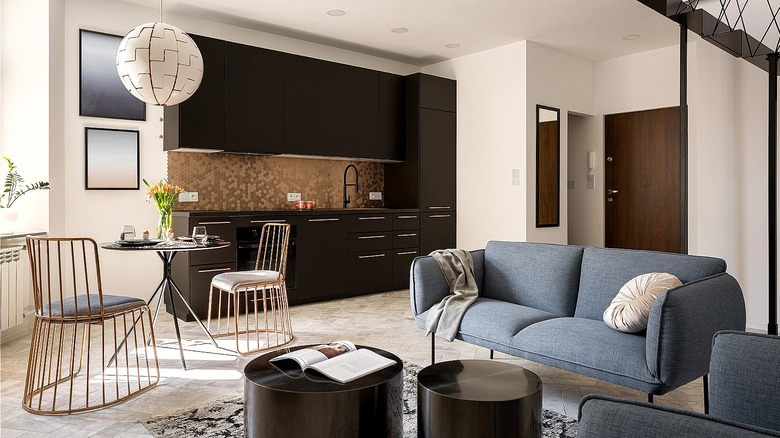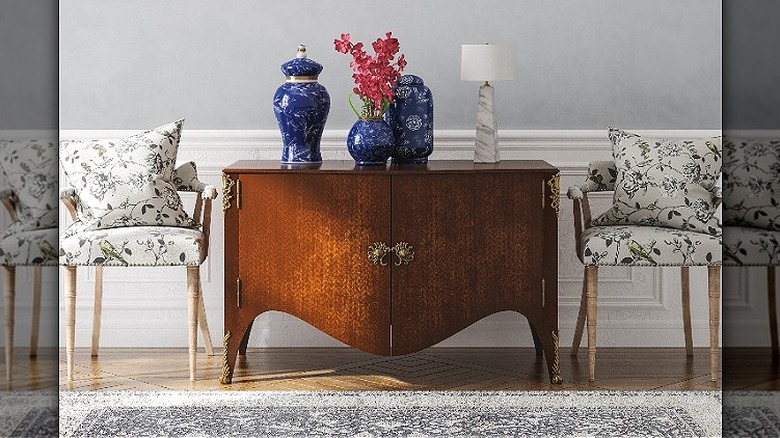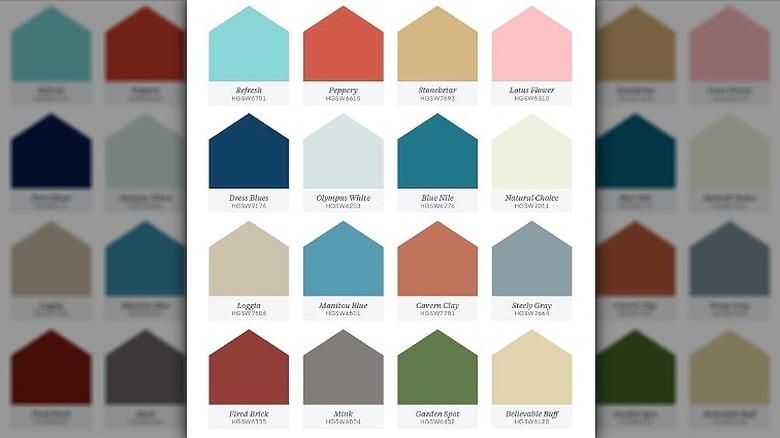The Best Color Palette For An Eclectic Home Décor Style
There's been a shift in decorating — from minimal, gray interiors and prescriptive styles to eclectic, colorful spaces that celebrate personality and unique elements. Lauren Lerner, the founder of Living with Lolo, said in Veranda, "Gray walls and countertops are on their way out and are being replaced with more warm neutrals and brighter colors."
Meanwhile, the proprietor of Black Awning Interiors, Bryan Frost, contends we should leave the hue behind and allow our home's architecture and history to suggest the interior aesthetic instead of defaulting to the look of the day. "Try a bold color for a refresh! Cabinet trends embrace greens and blues. Wallpaper doubles as artwork, bringing a colorful splash into a static neutral space," Frost shared.
One might think eclectic decorating is anything goes, a chance to let your free-spirited design muse run amok. All of this sounds exciting to eyes glazed over with gray. But tread carefully, because the classic tenets concerning balance, scale, and pattern mixing are as important as ever and integral to pulling off the look successfully, per Sherwin Williams. Decorist designer Emerie Forehand told My Domaine, "It's all about mixing, matching, and layering." Yet Forehand cautioned, "There is a method to the madness."
True to form, the eclectic paint palettes seem to be scattered, consisting (inconsistently) of shy, airy, juicy, brooding, or vivacious shades. Sherwin Williams highlights bold or earthy hues while Benjamin Moore features pastels and historic tones, and Lick spans them all. So which eclectic color scheme makes the best of the style?
A neutral palette showcases eclectic pieces
The eclectic décor aesthetic encompasses many styles and sometimes incorporates a few at once. Vintage, traditional, mid-century modern, and bohemian design, among others, can feature under the eclectic umbrella. Emerie Forehand offered this advice in My Domaine for approaching the assemblage that is an eclectic space: "Research three different styles you like, make one the dominant style, and pull from all three while looking for similarities." Yet she's quick to note, "Opposites also attract."
An overriding concept of the style, and a significant part of its appeal, is the opportunity to create surprising and fresh moments with the juxtaposition of unexpected elements. But for most of us, this can be tricky. To that end, Forehand proposes we start with (gasp) a neutral paint palette, which affords more risk-taking and vibrancy in furniture and decor. She likes a monochromatic scheme for the furniture and fabrics, which uses various shades of one color, creating design cohesion — even more paramount when you're combining periods and styles.
More than anything, eclectic design is about expressing your unique point of view and personality. That doesn't mean it has to be a boisterous one. Within the paint color collections, there are quiet options. If you prefer a neutral, subdued palette, you'll want to bring in plenty of texture. "Consider shaggy throw rugs or pillows, nubby or thick weave fabrics on furniture, rough wooden treasures or furniture, and soft, smooth finishes on iron or other metals," notes interior designer Jennifer Adams in Elle Decor.
A bold scheme highlights eclectic spirit
The Eclectic Mid-Century Collection from HGTV Home by Sherwin Williams (above) includes warm and cool neutrals but also numerous rich and earthy tones. The collaborators say attention-getting spaces that felt grounding and modern were their inspiration. They suggest compounding drama with statement art and wow lighting fixtures. Per Modsy, go strong with wall color, and even bolder with upholstery hues. Introduce logic into the design by staying primarily with a warm or cool palette, and energizing it with an opposite accent — e.g., blue paint, orange chair. When it's time to choose, follow this paint sampling tip from interior designer Rita Konig: "Paint the colors you like onto boards, then look at them in isolation," Konig explained in Elle Decor. "The colors will do weird things to each other, and it will get very confusing."
"The right paint colors can unify and add freshness to an eclectic, vintage-inspired space," notes Benjamin Moore design expert, Nivara Xaykao. Consider painting trim moldings in a hue rather than standard white; then carry it throughout the home. Or tie an accent wall shade in one space to the wallpaper in another. Additionally, fabrics can be a great avenue for echoing a color scheme (and they provide a depth more nuanced than painted walls can achieve). "Repetition breeds comfort," notes Emerie Forehand in My Domaine. Just as there is no right or wrong way to do eclectic, any colors are appropriate — it's all about how they're used together.


